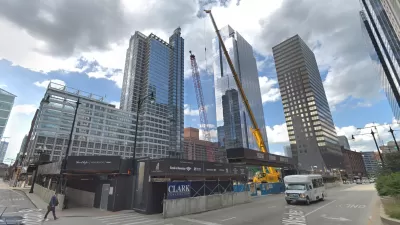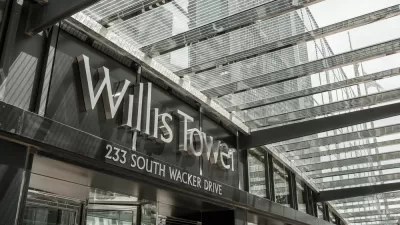When the Bank of America Tower opened in 2010 it was praised as the world's first LEED Platinum skyscraper. But data on the building's performance, post-occupation, show that it's actually an energy hog and massive greenhouse gas polluter.
"According to data released by New York City last fall, the Bank of America Tower produces more greenhouse gases and uses more energy per square foot than any comparably sized office building in Manhattan," reports Sam Roudman. "It uses more than twice as much energy per square foot as the 80-year-old Empire State Building. It also performs worse than the Goldman Sachs headquarters, maybe the most similar building in New York—and one with a lower LEED rating. It’s not just an embarrassment; it symbolizes a flaw at the heart of the effort to combat climate change."
"Certainly, many of the Bank of America Tower’s bells and whistles prevent it from consuming even more energy—and a lot of the energy it draws comes from cleaner sources than it otherwise could have. The building developers also showed me improved energy numbers for the year 2012, which will be released officially by the city in September," he adds. "But the fact that the Bank of America Tower became slightly less energy intensive is hardly a triumph for the environment."
FULL STORY: Bank of America's Toxic Tower

Planetizen Federal Action Tracker
A weekly monitor of how Trump’s orders and actions are impacting planners and planning in America.

Restaurant Patios Were a Pandemic Win — Why Were They so Hard to Keep?
Social distancing requirements and changes in travel patterns prompted cities to pilot new uses for street and sidewalk space. Then it got complicated.

Map: Where Senate Republicans Want to Sell Your Public Lands
For public land advocates, the Senate Republicans’ proposal to sell millions of acres of public land in the West is “the biggest fight of their careers.”

Orange County, Florida Adopts Largest US “Sprawl Repair” Code
The ‘Orange Code’ seeks to rectify decades of sprawl-inducing, car-oriented development.

Maui's Vacation Rental Debate Turns Ugly
Verbal attacks, misinformation campaigns and fistfights plague a high-stakes debate to convert thousands of vacation rentals into long-term housing.

San Francisco Suspends Traffic Calming Amidst Record Deaths
Citing “a challenging fiscal landscape,” the city will cease the program on the heels of 42 traffic deaths, including 24 pedestrians.
Urban Design for Planners 1: Software Tools
This six-course series explores essential urban design concepts using open source software and equips planners with the tools they need to participate fully in the urban design process.
Planning for Universal Design
Learn the tools for implementing Universal Design in planning regulations.
Heyer Gruel & Associates PA
JM Goldson LLC
Custer County Colorado
City of Camden Redevelopment Agency
City of Astoria
Transportation Research & Education Center (TREC) at Portland State University
Camden Redevelopment Agency
City of Claremont
Municipality of Princeton (NJ)





























